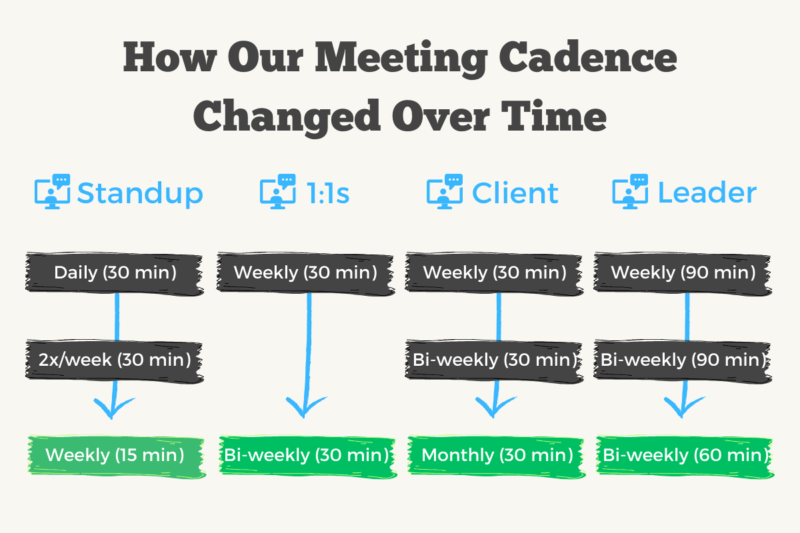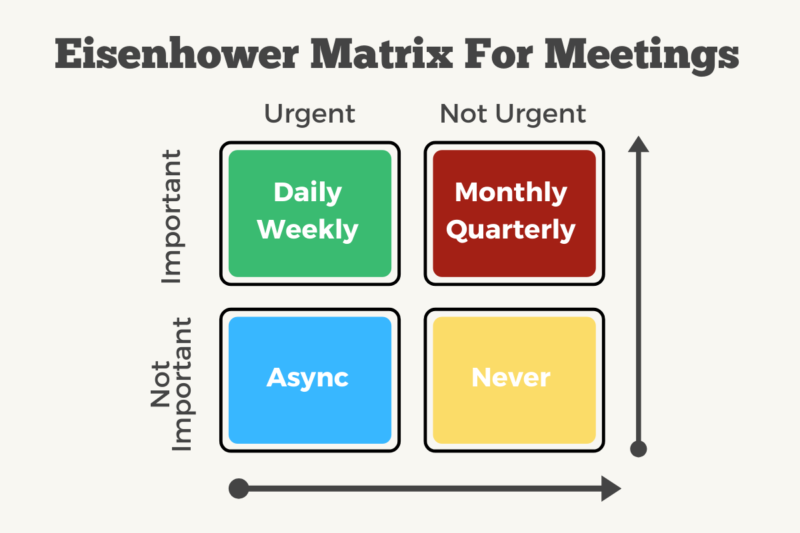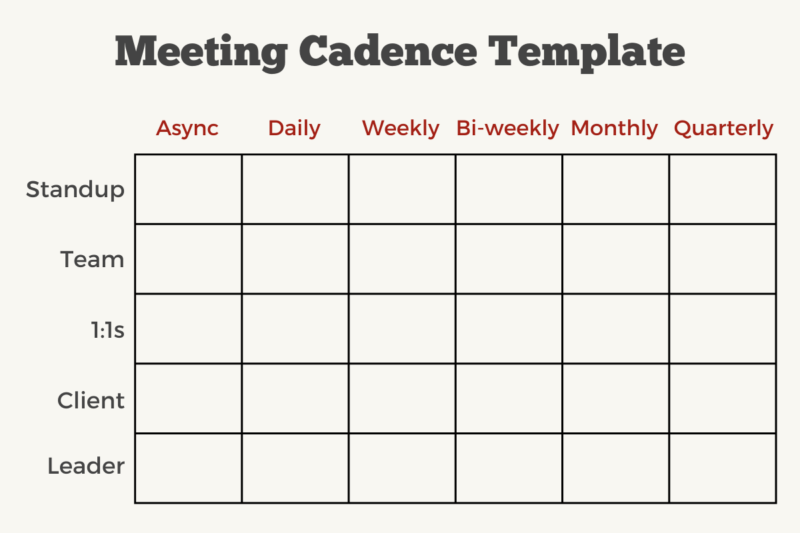How We Perfected Our Meeting Cadence

I ran a company for four years before I thought about our meeting cadence. That was a failure by me as the operator of the business. If you don’t put work into your systems, you’ll end up with whatever comes out the other side (and you may not like it).
When we decided to switch to a four-day work week, we reduced our work hours from 36 to 32 per week. People on the team were excited about it, but a few mentioned how they thought they may not be able to get all of their work done in fewer hours. That sent me on a quest to find four hours for everybody each week to show it could be done.
I started with our meetings, and particularly, our meeting cadence. We answered the following questions as a team:
- Which meetings can be cut out completely?
- Which one-hour meetings can be done in 30 minutes?
- Which 30-minute meetings can be done in 15?
- Which weekly meetings can go to bi-weekly?
- Which bi-weekly can skip to monthly?
We freed up valuable hours for deeper, more fulfilling work than meetings. I hope that, with this article, you too can redesign your cadence of meetings in a meaningful way.
Table of contents:
- Definition
- Why should you work on meeting cadence?
- How to critique your meetings
- How we settled on the right meeting cadence
- A meeting cadence template you can use
- Additional reading I recommend
Meeting Cadence Definition
Meeting cadence: frequency, timing, and length of discussions at your company
Meeting cadence refers to how often, how long, and when people get together in meetings at your organization. It’s the pulse of your organization’s synchronous communication.
Why should you work on your meeting cadence?
Simply put, if you don’t put thought into your meeting cadence, you may end up with a way of communicating you don’t like:
- Too frequent: Your amount of meetings overload your team
- Too infrequent: You don’t get on the same page enough, pulling people in different directions
- Inconsistent: Some teams are overloaded while others are out of touch
- Mismatched: Some meetings that should be 15 minutes are booked for an hour and vice versa
By discussing and designing your meeting cadence, you’ll build the communication system and workplace you intend to have. Here are the reasons to work on it:
Increase productivity
If you can cut out unnecessary meetings, you’ll shift hours from talking about work to doing work.
Reduce or eliminate meeting fatigue
Overloading employees with excessive meetings can lead to meeting fatigue, reducing the effectiveness of communication and collaboration. Analyzing cadence helps in preventing burnout and maintaining a high level of energy and focus.
Increase time for deep work
Every hour you can remove in meetings frees up time for what Cal Newport calls “Deep Work.” Deep work is the ability and opportunity to focus on a hard, creative, valuable task for an uninterrupted period of time.
Give employees autonomy over their time
In the book “Drive,” Daniel Pink says that people are motivated by autonomy, mastery, and purpose. When employees have days full of meetings, they don’t have control (or autonomy) over their time. Meeting overload is a structured removal of autonomy.
Use time more efficiently
A one-hour meeting with 10 people requires 10 work hours. An all-team meeting with 100 people would require 100 hours. When you start to analyze your meeting cadence, you’ll find huge opportunities to cut out inefficient blocks of time.
Build a culture of continuous improvement
Analyzing meeting cadence provides an opportunity for feedback and continuous improvement. It allows for employees to question the value of certain meetings. When you start opening those channels, more improvement will follow as employees are empowered.
How To Critique Meetings (To Find Out If They’re Useful)
One way to perfect your meeting cadence is to ask the following questions about each meeting that happens on your team. For your next round of meetings, ask each of these questions and the answers will uncover the value of the meeting.
When you discover a meeting does not lead to positive changes within the company, delete the meeting. Eventually, you’ll end up with purposeful meetings only.
For ad-hoc meetings
- Where does this fall on the Eisenhower Matrix?
- Can we decide asynchronously (without a meeting) instead?
- What do we need to decide or accomplish in this meeting?
- Who needs to be in the meeting? Who doesn’t?
- What needs to be prepared so we can have a better meeting?
For recurring meetings
- What is the goal of the meeting?
- Is this meeting the right length? (Does it typically run over or under?)
- Is the meeting the right frequency? (Do we make decisions and changes before the next meeting?)
- Do we have the right people in this meeting?
- Does everyone participate?
- Is the meeting topic urgent, important, both, or neither?
- Do we improve our strategy or process as a result of this meeting?
- Is the meeting duplicative with other recurring ones
How We Settled On The Right Meeting Cadence
By switching to a 32-hour work week, each work hour suddenly became more valuable. With that mindset shift, we started to cut down on meetings to free up time for real work. Most of this we did right away – within a week of switching our work schedule – but some work took years. Here’s how our meeting cadence changed over time.

Standups
Daily (30 min) > Twice weekly (30 min) > Weekly (15 min)
When we switched to agile project management, we started with daily 30-minute meetings. Once we got the hang of it, we dropped it to two meetings per week (Monday and Thursday). Then, we went to one, 15-minute meeting per week.
1:1 meetings
Weekly (30 min) > Bi-weekly (30 min)
The main value of this kind of meeting was relationship and trust building. Most tasks between the two people could be accomplished asynchronously, but spending one-on-one time on video is important for team building. But that didn’t need to take place weekly.
Team meetings
Weekly (1 hour) > Weekly (30 min)
Our all-team meeting eventually became a non-work meeting. We discovered over the years that our ice breakers and open discussions became most important for our remote team. The business stuff could get done elsewhere. Once we cut out the work updates, we cut the meeting in half.
Leadership meetings
Weekly (90 min) > Bi-weekly (90 min)
We put in the “Entrepreneur’s Operating System” (or, EOS) after reading “Traction: Get a Grip on Your Business” by Gino Wickman. This gave our meetings purpose and process, and it also gave us a weekly, 90-minute leadership meeting. Once we ran that way for a few years, we switched to bi-weekly, then cut it down to an hour.
Client meetings
Weekly (30 min) > Bi-weekly (30 min) > Monthly (30 min)
As a consulting business, we charged for meetings. When we did that weekly, it was an expensive part of the package. By moving it to bi-weekly then monthly, we could charge less for meetings and provide more value in other ways.
Meeting cadence template
I created a simple meeting cadence template to determine the right frequency based on the type of meeting.
You can customize the template in Canva. Or, you can recreate it in Excel or Word or anywhere else (it’s straightforward).
Write out the types of meetings you have
Write out the types of meetings* you have in any way that makes sense to you. This is how I categorized ours:
- Standups
- Team meetings
- One-on-one meetings
- Client meetings
- Leadership meetings
*Tip: If some meetings can’t be categorized, they may not be valuable.
See Also: 41 Types Of Meetings Defined: The Full Library
Write out the frequencies
Then, write out how frequently you want meetings to occur at your company. These are all of the options I can come up with:
- Asynchronous (no meeting)
- Daily
- Weekly
- Bi-weekly
- Monthly
- Quarterly
Pick the right cadence
With meeting type on one side of the table and frequency on the other, you can find the right cadence for meetings. Work with your team on this template. You’ll have a focused cadence soon enough.
See Also: 18 Quick Ways To Fight Off ‘Death By Meeting’ | The Guide To Meeting Etiquette
Experts To Follow On Meeting Cadence
If you’d like to learn more about meetings and meeting cadence, there are several great takeaways from experts. Below, you’ll see the name of the expert, my main takeaway, and a link to learn more.
Expert | Resource | My Takeaway |
 Daniel Pink | Drive (book) | People are motivated by autonomy, mastery, and purpose. Increase autonomy by decreasing meetings. |
 Dwight D. Eisenhower | Eisenhower.me (website) | Apply the Eisenhower Matrix to your meetings: Is the topic urgent, important, both, or neither? |
 Cal Newport | Deep Work (book) | Free up time for deep, fulfilling work by freeing up your team’s calendar. |
 Gino Wickman | Traction (Book) | Bring structure to your leadership team’s meetings with set agendas and time allotments. |
 Patrick Lencioni | Death by Meeting (book) | Get rid of bad meetings by taking a structured approach to every meeting – daily, weekly, monthly, quarterly. |
 Jeff Bezos | Two-Pizza Teams (concept) | If you need to buy more than two pizzas to feed a team, it’s too big. You can apply the same rule to meetings. |
 Julie Zhuo | The Making of a Manager (book) | Make sure every meeting has three things: clear agenda, inviting only necessary stakeholders, and ensuring that every meeting has a defined objective. |


